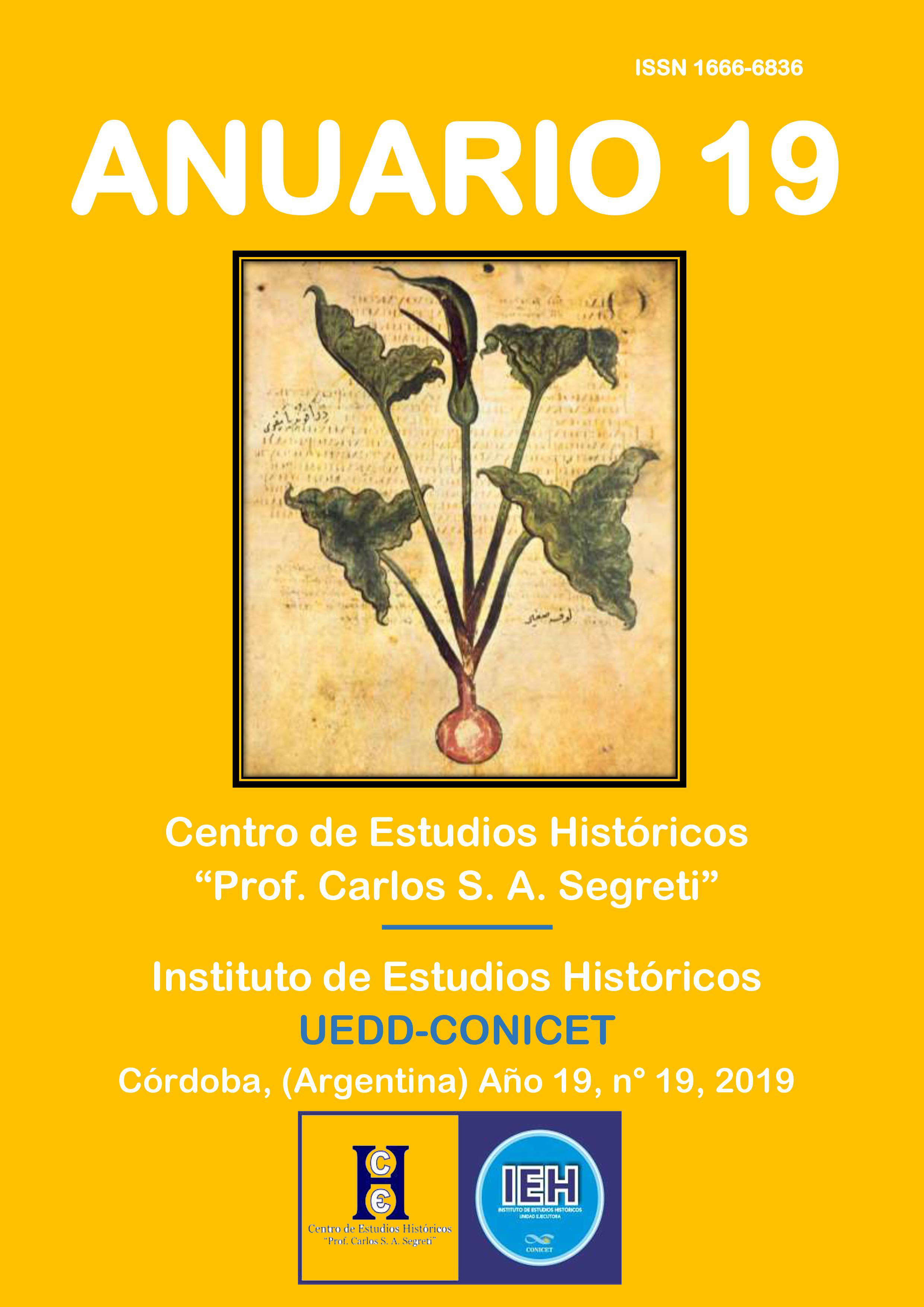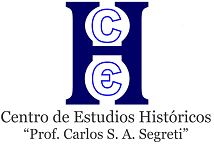Los nomina barbara en textos y artefactos mágicos de la Antigüedad Tardía: el caso de Iaô
DOI:
https://doi.org/10.52885/2683-9164.v.n19.25629Palabras clave:
Nomina barbara; Antigüedad Tardía; Iaô; entidades divinas; TetragrámatonResumen
El presente trabajo analiza los nomina barbara en la Antigüedad Tardía, a partir del análisis de la entidad divina Iaô, en diversas menciones presentes en variados corpora: Papiros Griegos Mágicos, y textos religiosos pertenecientes a comunidades judías y cristianas de dicho período. Nuestro objetivo consiste en visibilizar la utilidad del estudio de los nomina barbara, no solo para los estudios centrados en las polémicas apologéticas y transferencias entre diferentes comunidades religiosas coetáneas, sino también para evidenciar su relevancia en estudios referidos a las variaciones y concepciones en torno al Tetragrámaton, a partir de la centralidad de la figura de Iaô.
Descargas
Referencias
BAKOWSKA-CZERNER, Grazyna “Elements of Gnostic Concepts in Depictions on Magical Gems”, The Polish Journal of the Arts and Culture 13.1 (2015).
BETZ Hans D., The Greek Magical Papyri in Translation Including the Demotic Spells, Chicago, The University of Chicago Press, 1996.
BOHAK Gideon, Ancient Jewish Magic: A History, Cambridge, Cambridge University Press, 2008.
BONNER Campbell, Studies in Magical Amulets. Chiefly Graeco-Egyptians, Ann-Arbor, The University of Michigan Press, 1950.
CALVO MARTÍNEZ José Luis y SÁNCHEZ ROMERO María Dolores, Textos de magia en papiros griegos, Madrid, 1987.
DOSOO Korshi, “Magical Discourses, Ritual Collections: Cultural Trends and Private Interest in Egyptian Handbooks and Archives”.
FARAONE Christopher, The Transformation of Greek Amulets in Roman Imperial Times, Philadelphia, University of Pennsylvania Press, 2018.
FRANKFURTER David, Christianizing Egypt. Syncretism and Local Worlds in Late Antiquity, Princeton, Princeton University Press, 2018.
GARCÍA BAZÁN Francisco, La gnosis eterna. Antología de textos gnósticos, latinos y coptos I, Barcelona, Trotta, 2003.
ISBELL Charles D., Corpus of the Aramaic Incantation Bowls, Missoula, 1975.
JOOSTEN Jan, “Le Dieu Iaô et le Tréfonds Araméen des Septante”, en LOUBET Mireille, PRALON Didier (dir.), Eukarpa. Études sur la Bible et ses exégètes en hommage à Gilles Dorival, Paris, Cerf, 2011.
MASTROCINQUE Attilio, Les intailles magiques du Départament de monnaies, médailles et antiques, Paris, Bibliothèque national de France, 2014.
MICHEL Simone, Die magischen Gemmen im Britischen Museum, London, British Museum Press, 2001.
MICHEL-VON DUNGERN PHILONENKO Marc, “L’anguipède alectorocéphale et le Dieu Iaô”, en Comptes rendus des séances de l’Académie des Inscriptions et de Belles-Lettres, 1979.
MIMOUNI Simon y SCOPELLO Madeleine, “Introduction générale”, en Simon MIMOUNI y Madeleine SCOPELLO (dirs.), La Mystique théorétique et théurgique dans l’Antiquité gréco-romaine, Turnhout, Brepols, 2016.
MONTGOMERY James A., Aramaic Incantation Texts from Nippur, Philadelphie, 1913.
NAVEH Joseph y SHAKED Shaul, Amulets and Magic Bowls. Aramaic Incantations of Late Antiquity, Jerusalén – Leiden, 1985.
NAVEH Joseph y SHAKED Shaul, Magic Spells and Formulae: Aramaic Incantation of Late Antiquity, Jérusalem, 1993.
O.D. LOVE Edward, Code-Switching with the Gods. The Bilingual Old Coptic-Greek Spells of PGM IV and their Linguistic, Religious and Socio-Cultural Context in Late Roman Egypt, Berlin, de Gruyter, 2016.
PLEŠE Zlatko, “IAO”, en BAGNALL Roger S. et al. (eds.), The Encyclopedia of Ancient History, Blackwell Publishing, 2013.
PREISENDANZ Karl (ed.), Papyri Graecae Magicae. Die Griechischen Zauberpapyri, t. I-II, Teubner, Leipzig – Berlin, 1928-1931.
POGNON Henri, Inscriptions mandaïtes des coupes de Khouabir, t. I-III, Paris, 1898.
PORTEN Bezalel, The Elephantine Papyri in English Three Millennia of Cross-Cultural Continuity and Change Second Revised Edition, Atlanta, Society of Biblical Literature, 2011.
QUACK Joachim, “The So-Called Pantheos. On Polimorphic Deities in Late Egyptian Religion”, en GYÖRGY Hedvig, Aegyptus et Pannonia, Budapest, 2006.
TARDIEU Michel, “Introduction”, en TARDIEU Michel; VAN DEN KERCHOVE Anna; Michela ZAGO (dir.), Noms barbares I. Formes et contextes d’une pratique magique (Bibliothèque de l’Ecole des Hautes Etudes 162), Turnhout, Brepols, 2013.
TARDIEU Michel y DUBOIS Jean-Daniel, Introduction à la littérature gnostique I, Clamecy, CERF, 1986.
THOMASSEN Einar, “Gnostic Semiotics: The Valentinian Notion of the Name”, Temenos 29.
TROIANO Mariano, “Rituels et énoncés barbares dans la Pistis Sophia”, en SOARES SANTOPRETE Luciana G. y HOFFMANN Philippe (eds.), Langage des dieux, langage des démons, langage des hommes dans l’Antiquité, Turnhout, Brepols, 2017.
SCOPELLO Madeleine, Femme, Gnose et Manichéisme. De l’espace mythique au territoire du réel. Leiden – Boston, Brill, 2005.
VAN DER VLIET Jacques, “Literature, Liturgy, Magic: A Dynamic Continuum”, en BUZI Paula y CAMPLANI Alberto (eds.), Christianity in Egypt: Literary Production and Intellectual Trends in Late Antiquity. Studies in Honor of Tito Orlandi, Rome: Institutum Patristicum Augustinianum, 2011.
VITELLOZZI Paolo, “Relations Between Magical Texts and Magical Gems. Recent Perspectives”, en KIYANRAD Sarah et al. (eds.), Bild und Schrift auf 'magischen' Artefakten, Berlin, de Gruyter.
Descargas
Publicado
Número
Sección
Licencia
Aquellos autores/as que tengan publicaciones con esta revista, aceptan los términos siguientes:
- Los autores/as conservarán sus derechos de autor y garantizarán a la revista el derecho de primera publicación de su obra, el cuál estará simultáneamente sujeto a una Licencia de reconocimiento de Creative Commons. Se puede compartir, copiar, distribuir, ejecutar y comunicar públicamente la obra, siempre que: a) se cite la autoría y la fuente original de su publicación (revista, editorial y URL de la obra); b) no se use para fines comerciales; c) no se altere, transforme o genere una obra derivada a partir de esta obra.
- Los autores/as podrán adoptar otros acuerdos de licencia no exclusiva de distribución de la versión de la obra publicada (p. ej.: depositarla en un archivo telemático institucional o publicarla en un volumen monográfico) siempre que se indique la publicación inicial en esta revista.
- Se permite y recomienda a los autores/as difundir su obra a través de Internet (p. ej.: en archivos telemáticos institucionales o en su página web) después del proceso de publicación, lo cual puede producir intercambios interesantes y aumentar las citas de la obra publicada. (Véase El efecto del acceso abierto).









